Sat 17 Apr 2010
Reviewed by David L. Vineyard: WILLIAM SLOANE – To Walk the Night.
Posted by Steve under Covers , Reviews[7] Comments
WILLIAM SLOANE – To Walk The Night. Farrar & Rinehart, hardcover, 1937. World/Tower, hc reprint, 1946. Paperback reprints include: Penguin-US #550, 1944; Dell #856, 1957; Bantam H3426, 1967; Del Rey, 1980.
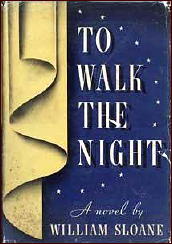
There are books that are not only genuinely scary, but more importantly genuinely disturbing. The scream or the sudden start is less part of their impact, than the frisson, that deep chill that rises from the soul and is often described as feeling as if someone has walked over your grave.
Most writers only manage one of these, however masterful their output: Cornell Woolrich’s Night Has 1000 Eyes (written as George Hopley), Shirley Jackson’s The Haunting of Hill House, Thomas Tryon’s The Other, Gordon Williams’ Neither the Sand Nor the Sea, Fritz Leiber’s Conjure Wife, Jack Williamson’s Darker Than You Think, and William Lindsey Gresham’s Nightmare Alley are a few examples of the form.
William Sloane was unique in that he wrote two books that fit this category. They were the only two books he wrote in a long and distinguished literary career which included being a vice president at Holt, editorial director at Funk and Wagnalls, director of Rutgers University Press, and founder of William Sloane Associates. Indeed, writing two classics on top of all that seems like overkill.
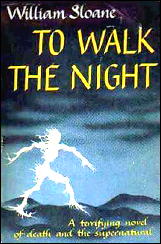
But classics they are. By far the best known of the pair was The Edge of Running Water (aka The Unquiet Corpse and filmed as The Devil Commands (reviewed here )), an acknowledged classic of the Campbellian school of fiction represented by the pulp magazine Unknown (despite the fact Sloane’s novels predate the Unknown school) where science fiction, fantasy, horror, the thriller, and the genuine gothic all cross.
But while Edge of Running Water is a genuine classic and a great work, by far the novel that held my imagination longest and still does was Sloane’s first novel, 1937’s To Walk the Night. It’s frights are more subtle than The Edge of Running Water, but no less disturbing.
To Walk the Night unfolds like a mystery novel. Bark Jones has gone home to visit Dr. Lister, the father of his friend Jerry, and together they hope to lay the mystery that revolves around the deaths of Jerry, and before him Jerry’s mentor astronomer Professor LeNormand. The one key to both men’s deaths is LeNormand’s, and now Jerry’s widow, Selena.
Selena.
There aren’t many women in fiction like Selena. She could stand beside Rider Haggard’s Ayesha without so much as a blush. She makes her entrance after her husband’s death — seemingly by spontaneous combustion — and for Jerry it is love at first sight. For Bark it is something else. A mystery that is both fascinating and horrible in its implications.
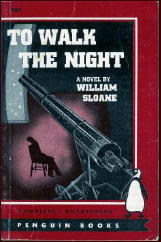
She is also stunningly beautiful though she dresses badly and seems equally indifferent to her beauty. Jerry woos her, and not two months after LeNormand’s death they marry and move to their new home in the American Southwest where Jerry plans to continue his mentors studies.
Meanwhile Bark continues to probe and try to put together some sense from Selena’s manner. Who is she? She doesn’t seem to have existed before two years earlier, and yet she closely resembles a severely brain damaged girl who disappeared at the same time Selena showed up.
At times she seems to actually have loved LeNormand and to love Jerry, and yet there is no passion in her, no humanity, and she is oddly and inexplicably ‘other.’ At one point she brakes a car before anyone could have known of the obstacle that appears before her.
She is simply not quite human, based on the smallest of evidence — the way she out shines a nightclub magician, or her strange ignorance of the most common of things. And yet she is a superb dancer, a normal housewife, and in her own way seems to genuinely love her husband.
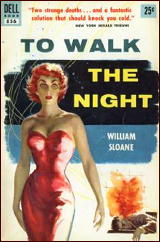
But Jerry will not abandon his research, and as he comes closer to the same revelations that drove his mentor, a crisis is approaching.
The detail of incident is built slowly and Bark frequently apologizes to the reader for dwelling on the tiny incidents that comprise his story. But subtly and with increasing tension the reader begins to feel the very real dread that is building — much like a nightmare that one can’t be awakened from. Even Jerry feels it, something is not quite right:
Probably every married man has experienced that feeling at some point in his marriage, no matter how happy his marriage is overall, but with Selena the worry is real. It’s a mark of Sloane’s skill as a writer that he manages a moment of genuine frisson from a fairly normal moment between a man and a woman that in other hands might spark an episode of a sitcom.
What that something is worries at Jerry’s mind. He knows if he can identify it he can lay not only the mystery of what or who killed LeNormand, but also put an end to that distance between he and Selena.
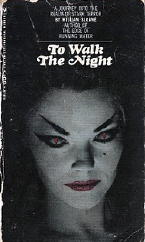
And in a way he is right, because LeNormand’s calculations are the key to everything; his death, Selena’s peculiar nature, and Jerry’s fate, and unraveling that final mystery will be a fatal mistake. Some things we aren’t meant to know …
To Walk the Night (the title comes from Selena’s nocturnal walks in the high desert) does not disappoint. The solution veers into true science fiction, and yet I can’t honestly call this a science fiction novel. It reads much more like a suspense novel or a true gothic. In fact what genre, if any, it belongs to is a minor consideration. It transcends genre, and stands on its own as simply a stunningly good read.
Sloane is a first rate writer and the novel is beautifully written. The ending is haunting, and yet understated with genuine power.
Don’t finish this one right before bed. You are apt to have a restless night, not so much from fear exactly, but because you can’t quite let go of this, even when you want to.
I’ll let Selena speak for herself. This speech is from Selena to Jerry’s father, Dr. Lister, near the very end of the novel:
Though she addresses herself to Jerry’s father, it is mankind she is speaking to, and mankind itself that will no longer exist when the world has ‘traveled around the sun a few more times.’
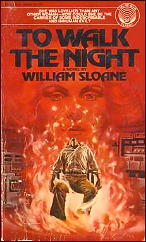
This would have been a remarkable novel to be written after the birth of the nuclear age and after the devastation of the Second World War. To be written before it is all the more remarkable.
By all means read this one. But keep the light on. And for those of you married men, if you find yourself wondering about the ‘other’ in your life, blame Sloane, not me. To Walk the Night is a murder mystery, and it does have real clues, and an actual solution, but like Robert Louis Stevenson’s The Strange Case of Dr. Jekyll and Mr. Hyde, the solution may well be more horrible than the crime.
Note: There seems to be some confusion as to whether the 1963 British film Unearthly Stranger with John Neville is based on Sloane’s novel or not. The stories are similar, but not having seen the film I don’t know if Sloane is credited in the screen credits or not.
IMDb does not mention Sloane as the source for the film, but I have seen it described elsewhere as being based on Sloane’s novel. Maybe someone out there can solve the mystery. No doubt it will be a less disturbing solution than the one to Sloane’s novel.
April 18th, 2010 at 12:56 pm
A comment about covers. For David’s review I was lucky enough to find images of all six of the US editions I came up with for the book.
It’s the Dell edition that I’m the most familiar with. It’s the one caught my attention back when I was 15 or 16, and of course it immediately prompted me to sit down and read it.
Or try to. I just as immediately didn’t understand it. Boring, I thought, and I doubt that I finished it. I certainly don’t remember it.
But I do remember the cover.
Take a look at all of them, if you would. Whether you’ve read the book or not, which of them would catch your eye and entice you into reading it?
I’d vote for the Tower hardcover (the second one down) and (naturally) the Dell paperback.
The rest are rather generic and/or blah, though the girl on Bantam paperback looks exotic enough for me to take another look.
Then, if I may, those of you who’ve read the book. Which one’s the actual best representation of what’s inside?
— Steve
April 18th, 2010 at 1:28 pm
Steve
The two covers you mention are the ones that would have attracted me knowing nothing about the book, though the one that damn near gives away a key element of the story is the Del Rey, and while it can’t compare to the Dell or the exotic girl on the Bantam, you have to enjoy the Penguin looking through the telescope.
The Del Rey cover and Bantam for EDGE OF RUNNING WATER are both better than the ones for this one.
I can certainly see where this one might seem dull to a 15 year old — especially with what that Dell cover seems to promise. It’s a deliberate novel that builds its suspense and chills on the slow accumulation of incidents instead of sharp jolts and scares. The big shock comes once you close the book and its implication begin to dawn on you.
Oddly the books this reminds me the most of are Woolrich’s NIGHT HAS 1000 EYES and Tryon’s THE OTHER. Not in terms of the plot or story, but in that slow accumulation of little disturbances building to something ‘orrible waiting in the dark. This is the rare book that stays with you, one that still lingers long after you put it down, which is why to some extent none of the covers quite does it justice.
April 20th, 2010 at 6:21 am
I’m afraid I’ve never been a big fan of Sloane; EDGE was interesting and off-beat but somehow uninvolving, and I found TO WALK THE NIGHT slow and surprisingly predictable, if you’ll pardon the oxymoron.
April 21st, 2010 at 3:21 am
Dan
I understand anyone who finds either of these slow. Sloane certainly wasn’t trying for simple thrills. He’s much more interested in the gradual accumulation of dread reminding me somewhat of Woolrich’s I MARRIED A DEAD MAN or WALTZ IN DARKNESS, books that don’t have a great deal of incident, but build slowly and with deliberation. Though Woolrich was a much pulpier, vivid, and involving writer.
On the other hand this was chosen as one of the 100 Best Modern Fantasy novels on the grounds of that accumulation of detail.
I doubt I would have paid half as much attention to it, if I hadn’t been older when I read it. That isn’t to say this will be appreciated only by more mature readers, only that this reader had to be more mature to appreciate it. I’m reminded of something comic book artist Neal Adams once said of the great PRINCE VALIANT creator Harold Foster. He had to grow up to recognize Foster’s accomplishment. I’m not sure if I’d read this before thirty it would have appealed half as much to me.
But none of that means anyone else should like it. That’s subjective and depends on the individual. The only thing it says about any reader is he liked or didn’t like a particular book. There are plenty of classics I’d rather be shot than have to read again.
The only place I would argue is on the ‘predictable’ part. Perhaps now in wake of many books like it, but believe me, when it was written that ending was not the least predicable. If it has been borrowed countless times since doesn’t lessen Sloane’s accomplishment. Rider Haggard’s SHE is no less original for the small army of want-to-be Ayesha’s who came in it’s wake.
But slow? Yes. But then so are glaciers, and look what they can accomplish — though I’ll grant you might not want to watch one. I only think some of what you didn’t like weren’t failures on Sloane’s part, but choices, which is a little different than when a writer fails at what he is doing.
September 18th, 2010 at 4:33 pm
Wonderful article! Thank you so much — that’s one of my favorite obscure horror novels. (And I was going nuts trying to think of the name of the film. I saw it years ago and loved it, though it’s nothing like the book.)
November 9th, 2010 at 1:24 pm
I wonder why I can find nothing on the internet that mentions the amazing similarity between this novel’s plot and a story published only a few years prior in Edward Heron-Allen’s THE STRANGE PAPERS OF DR. BLAYRE (Philip Allan, 1932). The story is called “Aalila” and tells of an astronomer who makes contact with a being resembling a woman who lives on Venus. She manages to teleport to Earth. When she makes contact with the astronomer he is destroyed in exactly the same manner as the death of the professor in Sloane’s novel. Did he know the story? Seems far too coincidental for two writers to come up with this bizarre storyline only five years apart.
April 19th, 2022 at 3:01 pm
To Walk the Night was filmed as a TV episode of season 3 of Robert Montgomery Presents. The otherworldly woman was played by Geraldine Fitzgerald. I’ve been looking everywhere for the episode, to no avail…